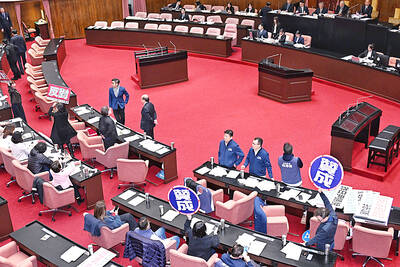A Ministry of National Defense (MND) spokesman yesterday confirmed that Taiwan was developing an unmanned surveillance aircraft (UAV), a move that provides further confirmation of a continuing arms race despite closer political and economic ties with China.
Ministry spokesman Major General Yu Sy-tue (虞思祖) said the Chung-Shan Institute of Science and Technology (CSIST, 中山科學研究院), which falls under the ministry’s Armaments Bureau, had initiated research on drones.
According to defense analysts, research on indigenous reconnaissance UAVs has been going on for at least a decade. The institute unveiled a number of UAVs in August last year — including an operational version of the Chung Shyang (中翔) — during the Taipei Aerospace and Defense Technology Exhibition and Conference in Taipei.
A CSIST representative told Defense News at the time that the first Chung Shyang was built in 2007, with five prototypes already operational.
Asked by the Taipei Times whether the air force was seeking to obtain the Chung Shyang, which appears to be the institute’s most advanced prototype, a ministry spokesman said that “new models” were still in the research and development phase, without elaborating.
With a range of 100km and capability to fly eight hours without stopping, the Chung Shyang has day-and-night surveillance and reconnaissance capabilities and can serve as a communications relay, Defense News said.
In March, the Liberty Times (the Taipei Times’ sister paper) reported that the army had announced it would soon deploy the nation’s first UAV under its Aviation and Special Warfare Command, though no date was given.
Yu’s announcement came a day after Minister of National Defense Kao Hua-chu (高華柱) told the legislature that the ministry had not put a US-built UAV, the Global Hawk, on its procurement list, opting instead to develop its own version.
“The air force has identified the need to acquire unmanned aircraft, but has not included the US-built reconnaissance aircraft system on its arms procurement list,” Kao said.
He also said that Taiwan, with CSIST in the lead, had been developing unmanned vehicles “for quite some time.”
Earlier on Monday, the Chinese-language China Times reported that Japan has come up with a Global Hawk procurement plan after the US military stationed the aircraft in Guam last month.
The paper also quoted unidentified military sources as saying that the air force was conducting an assessment on whether to follow suit and that it would put both F-16C/D fighter aircraft and the Global Hawk on its priority procurement list.
Wendell Minnick, Asia bureau chief of Defense News, told the Taipei Times it was unlikely the US would ever agree to sell Global Hawks to Taiwan.

A car bomb killed a senior Russian general in southern Moscow yesterday morning, the latest high-profile army figure to be blown up in a blast that came just hours after Russian and Ukrainian delegates held separate talks in Miami on a plan to end the war. Kyiv has not commented on the incident, but Russian investigators said they were probing whether the blast was “linked” to “Ukrainian special forces.” The attack was similar to other assassinations of generals and pro-war figures that have either been claimed, or are widely believed to have been orchestrated, by Ukraine. Russian Lieutenant General Fanil Sarvarov, 56, head

SAFETY FIRST: Double the number of police were deployed at the Taipei Marathon, while other cities released plans to bolster public event safety Authorities across Taiwan have stepped up security measures ahead of Christmas and New Year events, following a knife and smoke bomb attack in Taipei on Friday that left four people dead and 11 injured. In a bid to prevent potential copycat incidents, police deployments have been expanded for large gatherings, transport hubs, and other crowded public spaces, according to official statements from police and city authorities. Taipei Mayor Chiang Wan-an (蔣萬安) said the city has “comprehensively raised security readiness” in crowded areas, increased police deployments with armed officers, and intensified patrols during weekends and nighttime hours. For large-scale events, security checkpoints and explosives

‘POLITICAL GAME’: DPP lawmakers said the motion would not meet the legislative threshold needed, and accused the KMT and the TPP of trivializing the Constitution The Legislative Yuan yesterday approved a motion to initiate impeachment proceedings against President William Lai (賴清德), saying he had undermined Taiwan’s constitutional order and democracy. The motion was approved 61-50 by lawmakers from the main opposition Chinese Nationalist Party (KMT) and the smaller Taiwan People’s Party (TPP), who together hold a legislative majority. Under the motion, a roll call vote for impeachment would be held on May 19 next year, after various hearings are held and Lai is given the chance to defend himself. The move came after Lai on Monday last week did not promulgate an amendment passed by the legislature that

PENTAGON ASSESSMENT: A US report said that even as China and Russia deepen their partnership, cooperation is hindered by a ‘mutual distrust’ of each other The Chinese People’s Liberation Army (PLA) as of October had doubled the number of ships and airplanes deployed around Taiwan compared with the previous two years, Vice Minister of National Defense Hsu Szu-chien (徐斯儉) said yesterday, a day after the opposition-controlled legislature voted against reviewing the government’s general budget for next year, including a NT$1.25 trillion (US$39.71 billion) special defense spending bill. The legislature’s vote against the Ministry of National Defense’s spending plans was regrettable, as the budget was designed to respond to the developing Chinese military threat, Hsu said on the sidelines of a legislative meeting on the general budget. Defense